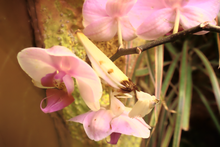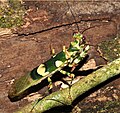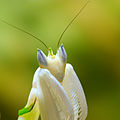Hymenopodidae: Difference between revisions
Content deleted Content added
Roy Bateman (talk | contribs) →Subfamilies: distributions (from MSF) |
Roy Bateman (talk | contribs) →Subfamilies: correct Phyllocraniinae dist. |
||
| Line 18: | Line 18: | ||
* [[Hymenopodinae]], Giglio-Tos, 1919 |
* [[Hymenopodinae]], Giglio-Tos, 1919 |
||
* [[Oxypilinae]], Giglio-Tos, 1919 |
* [[Oxypilinae]], Giglio-Tos, 1919 |
||
* Phyllocraniinae |
* Phyllocraniinae - genera: |
||
** ''[[Parablepharis]]'' |
** ''Parablepharis'' Saussure, 1870: monotypic ''[[Parablepharis kuhlii]]'' de Haan, 1842 ([[Indo-China]]) |
||
** ''[[Phyllocrania]]'' Burmeister, 1838 |
** ''[[Phyllocrania]]'' Burmeister, 1838 (Africa) |
||
* Phyllothelyinae - Asia - genera: |
* Phyllothelyinae - Asia - genera: |
||
** ''[[Ceratocrania]]'' Westwood, 1889 |
** ''[[Ceratocrania]]'' Westwood, 1889 |
||
Revision as of 12:17, 10 October 2018
| Hymenopodidae | |
|---|---|

| |
| Adult female Hymenopus coronatus | |

| |
| Adult female Hestiasula brunneriana | |
| Scientific classification | |
| Domain: | Eukaryota |
| Kingdom: | Animalia |
| Phylum: | Arthropoda |
| Class: | Insecta |
| Cohort: | Polyneoptera |
| Superorder: | Dictyoptera |
| Order: | Mantodea |
| Family: | Hymenopodidae Giglio-Tos, 1927 |
| Subfamilies | |
Hymenopodidae is a family of the order Mantodea (mantises), which contains four subfamilies. Some of the species in this family mimic flowers and are found camouflaged among them; these are called Flower Mantises. The coloration is aggressive mimicry, luring prey to approach close enough to be seized and eaten.
Subfamilies
The Mantodea Species File[1] lists:
- Acromantinae, Giglio-Tos, 1919
- Hymenopodinae, Giglio-Tos, 1919
- Oxypilinae, Giglio-Tos, 1919
- Phyllocraniinae - genera:
- Parablepharis Saussure, 1870: monotypic Parablepharis kuhlii de Haan, 1842 (Indo-China)
- Phyllocrania Burmeister, 1838 (Africa)
- Phyllothelyinae - Asia - genera:
- Ceratocrania Westwood, 1889
- Phyllothelys Wood-Mason, 1877
- Sibyllinae - Africa - genera:
- Leptosibylla Roy, 1996
- Presibylla Bolivar, 1908
- Sibylla Stal, 1856
The Epaphroditinae Giglio-Tos, 1915 (from the Caribbean) are now placed in a separate family Epaphroditidae.
Additional Images
-
Sudanese Hymenopodid Mantis, Pseudocreobotra species
-
Adult female Chlidonoptera vexillum.
-
Adult female Pseudoharpax virescens
-
Adult female Pseudocreobotra wahlbergii
-
Adult male Creobroter gemmatus
-
Dead adult female Creobroter gemmatus
-
Adult female Acromantis japonica
-
Adult female Ephestiasula species
-
Four dead adult female Hymenopus coronatus
-
Dead adult male Hymenopus coronatus
-
Sub-adult female Hymenopus coronatus head
-
Sub-adult female Hymenopus coronatus
-
Sub-adult female Hymenopus coronatus eating
-
Adult female Ceratomantis saussurii
-
Sub-adult female Phyllocrania paradoxa
-
Two adult female Phyllocrania paradoxa
-
Sub-adult female Phyllocrania paradoxa
-
Male Phyllocrania paradoxa, probably sub-adult
-
Adult female Hestiasula brunneriana
-
Dead adult female Pseudoharpax virescens
-
Dead adult female Pseudoharpax virescens
-
Pseudoharpax virescens nymphs threatening each other, in the older nymph stages, probably presub/sub-adult
-
Mating pair of Pseudoharpax virescens
-
Adult female Pseudoharpax virescens laying an ootheca
-
Pseudoharpax virescens hatching
-
Adult female Pseudoharpax virescens
See also
References
External Links
 Media related to Hymenopodidae at Wikimedia Commons
Media related to Hymenopodidae at Wikimedia Commons- Tree of Life - Hymenopodidae






























